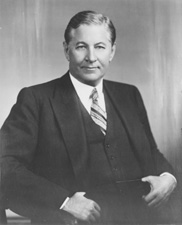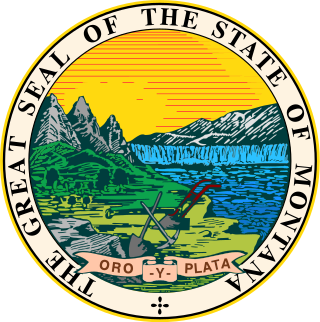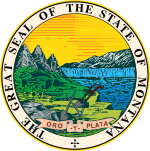
The 1976 United States Senate elections was an election for the United States Senate. Held on November 2, the 33 seats of Class 1 were contested in regular elections. They coincided with Democrat Jimmy Carter's presidential election and the United States Bicentennial celebration. Although almost half of the seats decided in this election changed parties, Carter's narrow victory did not provide coattails for the Democratic Party.

The 1964 United States Senate elections were held on November 3. The 33 seats of Class 1 were contested in regular elections. Special elections were also held to fill vacancies. They coincided with the election of President Lyndon B. Johnson by an overwhelming majority, to a full term. His Democratic Party picked up a net two seats from the Republicans. As of 2022, this was the last time either party has had a two-thirds majority in the Senate, which would have hypothetically allowed the Senate Democrats to override a veto, propose constitutional amendments, or convict and expel certain officials without any votes from Senate Republicans. In practice, however, internal divisions effectively prevented the Democrats from doing so. The Senate election coincided with Democratic gains in the House in the same year.

Thomas James Walsh was an American lawyer and Democratic Party politician from Helena, Montana who represented Montana in the US Senate from 1913 to 1933. He was initially elected by the state legislature, and from 1918 on by popular vote, in keeping with the requirements of the Seventeenth Amendment to the United States Constitution.

The 1982 United States Senate election in Montana took place on November 2, 1982. Incumbent United States Senator John Melcher, who was first elected to the Senate in 1976, opted to run for re-election. He won the Democratic primary after he faced a tough intraparty challenger, and advanced to the general election, where he faced Larry R. Williams, an author and the Republican nominee, and Larry Dodge, the Libertarian nominee. Though his margin was reduced significantly from his initial election, Melcher still comfortably won re-election to his second and final term in the Senate.

The 1924 United States Senate election in Montana took place on November 4, 1924. Incumbent United States Senator Thomas J. Walsh, who was first elected to the Senate in 1912 by the state legislature, and re-elected in 1918 by popular vote, ran for re-election. He was unopposed in the Democratic primary.

The 1930 United States Senate election in Montana took place on November 4, 1930. Incumbent United States Senator Thomas J. Walsh, who was first elected to the Senate in 1912, and re-elected in 1918 and 1924, ran for re-election. He won the Democratic primary unopposed, and faced Montana Supreme Court Associate Justice Albert J. Galen, the Republican nominee, and several independent opponents in the general election. Ultimately, Walsh defeated his opponents in a landslide and won his fourth and final term in the Senate.

The 1934 United States Senate special election in Montana took place on November 6, 1934. Incumbent United States Senator John E. Erickson, who, as governor, had appointed himself to the seat in 1933 upon the death of Thomas J. Walsh, ran for re-election. However, he was defeated in the Democratic primary by James E. Murray, who was the former Silver Bow County Attorney and the Chairman of the State Advisory Board of the Public Works Administration. In the general election, Murray defeated Scott Leavitt, a former United States Congressman who had represented Montana's 2nd congressional district, and an independent candidate in a landslide to win his first term in the Senate.

The 1930 United States Senate election in Montana took place on November 3, 1936. Incumbent United States Senator James E. Murray, who was first elected to the Senate in a special election in 1934, ran for re-election. He narrowly emerged from a competitive and close Democratic primary, wherein he was challenged by United States Congressman Joseph P. Monaghan, who represented Montana's 1st congressional district. In the general election, Murray was opposed by Thomas O. Larson, a State Senator and the Republican nominee, and Monaghan, who, after losing the primary, ran as an independent candidate. Murray ended up winning a second term, and his first full term, in a landslide, defeating both of his opponents by a comfortable margin.

The 1942 United States Senate election in Montana took place on November 3, 1942. Incumbent United States Senator James E. Murray, who was first elected to the Senate in a special election in 1934 and was re-elected in 1936, ran for re-election. Following his victory in a competitive Democratic primary, Murray advanced to the general election, where he was opposed by former United States Attorney for the District of Montana Wellington D. Rankin, the Republican nominee and brother of representative Jeannette Rankin. In a closely fought election, Murray narrowly defeated Rankin to win re-election to his third term and his second full term in the Senate.

The 1948 United States Senate election in Montana took place on November 2, 1948. Incumbent United States Senator James E. Murray, who was first elected to the Senate in a special election in 1934 and was re-elected in 1936 and 1942, ran for re-election. After winning the Democratic primary, he faced Tom J. Davis, an attorney and the Republican nominee, in the general election. Following a narrow re-election in 1936, Murray significantly expanded his margin of victory and comfortably won re-election over Davis, resulting in him winning his fourth term and his third full term in the Senate.

The 1972 United States Senate election in Montana took place on November 7, 1972. Incumbent United States Senator Lee Metcalf, who was first elected to the Senate in 1960 and was re-elected in 1966, ran for re-election. After winning the Democratic primary, he moved on to the general election, where he faced Hank Hibbard, a State Senator and the Republican nominee. Following a close campaign, Metcalf managed to narrowly win re-election to his third term in the Senate over Hibbard.

The 1984 United States Senate election in Montana took place on November 6, 1984. Incumbent United States Senator Max Baucus, who was first elected in 1978, ran for re-election. He easily won renomination in the Democratic primary, and advanced to the general election, where he faced Chuck Cozzens, a former State Representative and the Republican nominee. Despite President Ronald Reagan's strong performance in the state that year, Baucus was able to easily win a second term over Cozzens.

The 1922 United States Senate election in Montana took place on November 7, 1922. Incumbent United States Senator Henry L. Myers, who was first elected to the Senate in 1910, and was re-elected in 1916, declined to seek re-election. Former United States Attorney Burton K. Wheeler won the Democratic primary and advanced to the general election, where he faced Carl W. Riddick, the United States Congressman from Montana's 2nd congressional district and the Republican nominee. Ultimately, Wheeler defeated Riddick comfortably and won his first term in the Senate.

The 1928 United States Senate election in Montana took place on November 6, 1928. Incumbent United States Senator Burton K. Wheeler, who was first elected to the Senate in 1922, ran for re-election. After successfully defeating several challengers in the Democratic primary, Wheeler advanced to the general election, where he faced Republican nominee Joseph M. Dixon, the former Governor of Montana who had previously served in the United States Senate from 1907 to 1913. Though the election was closer than Wheeler's first election, he still managed to defeat Dixon to win his second term in the Senate.

The 1940 United States Senate election in Montana took place on November 5, 1940. Incumbent United States Senator Burton K. Wheeler, who was first elected to the Senate in 1922, and was re-elected in 1928 and 1934, ran for re-election. Though he faced a serious challenger in the Democratic primary, he emerged victorious, and advanced to the general election, where he faced E. K. Cheadle, a state district judge and the Republican nominee. Just like in 1934, Wheeler won re-election in a landslide, winning his fourth term in the Senate.

The 1946 United States Senate election in Montana took place on November 5, 1946. Incumbent United States Senator Burton K. Wheeler, who was first elected to the Senate in 1922, and was re-elected in 1928, 1934, and 1940, ran for re-election. He was challenged in the Democratic primary by Leif Erickson, the Chief Justice of the Montana Supreme Court, and, following a close election, was narrowly defeated by Erickson. In the general election, Erickson faced State Senator Zales Ecton, the Republican nominee. Ultimately, Ecton defeated Erickson by a fairly wide margin, winning his first and only term in the Senate. Another Republican would not be elected Senator from Montana until 42 years later, when Conrad Burns narrowly won the 1988 election.

The 1952 United States Senate election in Montana took place on November 4, 1952. Incumbent United States Senator Zales Ecton, who was first elected to the Senate in 1946, ran for re-election. Ecton won the Republican primary uncontested, and advanced to the general election, where he faced Mike Mansfield, the United States Congressman from Montana's 1st congressional district and the Democratic nominee. Following a close campaign, Mansfield narrowly defeated Ecton, winning his first of several terms in the Senate.

The 1958 United States Senate election in Montana took place on November 4, 1958. Incumbent United States Senator Mike Mansfield, who was first elected to the Senate in 1952, ran for re-election. Mansfield won the Democratic primary comfortably, and moved on to the general election, where he was opposed by Lou W. Welch, a millworker and the Republican nominee. In contrast to the close campaign in 1952, Mansfield defeated Welch in a landslide and won his second term in the Senate easily.

The 1964 United States Senate election in Montana took place on November 3, 1964. Incumbent United States Senator Mike Mansfield, who was first elected to the Senate in 1952 and was re-elected in 1958, ran for re-election. Mansfield won the Democratic primary in a landslide, and advanced to the general election, where he faced Alex Blewett, the Majority Leader of the Montana House of Representatives and the Republican nominee. Though Mansfield's margin was quite reduced from 1958, he still overwhelmingly defeated Blewett and won his third term in the Senate in a landslide.

The 1970 United States Senate election in Montana took place on November 3, 1970. Incumbent U.S. Senator Mike Mansfield, the sitting Senate majority leader who was first elected to the Senate in 1952 and was re-elected in 1958 and 1964, ran for re-election. Mansfield won the Democratic primary against several opponents, and advanced to the general election, where he was opposed by Harold E. Wallace, a sporting goods salesman and the Republican nominee. While his margin of victory decreased slightly from 1964, Mansfield still managed to defeat Wallace in a landslide, winning his fourth and final term in the Senate.


















